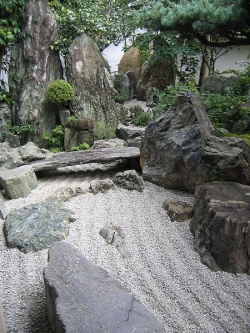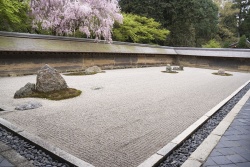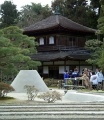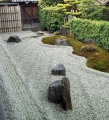Zen garden

The Japanese rock garden (枯山水 karesansui) or "dry landscape" garden, often called a zen garden, creates a miniature stylized landscape through carefully composed arrangements of rocks, water features, moss, pruned trees and bushes, and uses gravel or sand that is raked to represent ripples in water. A zen garden is usually relatively small, surrounded by a wall, and is usually meant to be seen while seated from a single viewpoint outside the garden, such as the porch of the hojo, the residence of the chief monk of the temple or monastery. Classical zen gardens were created at temples of Zen Buddhism in Kyoto, Japan during the Muromachi Period. They were intended to imitate the intimate essence of nature, not its actual appearance, and to serve an aid to meditation about the true meaning of life.
History
Early Japanese rock gardens
Rock gardens existed in Japan at least since the Heian Period (784-1185). These early gardens were described in the first manual of Japanese gardens, Sakuteiki (Records of Garden Keeping), written at the end of the 11th century by Tachibana no Toshitsuna (1028–1094). They were largely copied from the Chinese gardens of the Song Dynasty (960-1279), where groups of rocks symbolized Mount Penglai, the legendary mountain-island home of the Eight Immortals in Chinese mythology, known in Japanese as Horai. The Sakuteiki described exactly how rocks should be placed. In one passage, he wrote: "In a place where there is neither a lake or a stream, one can put in place what is called a kare-sansui, or dry landscape..." This kind of garden featured either rocks placed upright like mountains, or laid out in a miniature landscape of hills and ravines, with few plants. He described several other styles of rock garden, which usually included a stream or pond, including the great river style, the mountain river style, and the marsh style. The ocean style featured rocks that appeared to have been eroded by waves, surrounded by a bank of white sand, like a beach.
White sand and gravel had long been a feature of Japanese gardens. In the Shinto religion, it was used to symbolize purity, and was used around shrines, temples, and palaces. In zen gardens, it represents water, or, like the white space in Japanese paintings, emptiness and distance.
Zen Buddhism and the Muromachi Period (1336-1573)
The Muromachi Period in Japan, which took place at roughly the same time as the Renaissance in Europe, was characterized by political rivalries which frequently led to wars, but also by an extraordinary flourishing of Japanese culture. It saw the beginning of Noh theater, the Japanese tea ceremony, the shoin style of Japanese architecture, and the zen garden.
Zen Buddhism was introduced into Japan at the end of the 12th century, and quickly achieved a wide following, particularly among the Samurai class and war lords, who admired its doctrine of self-discipline. The gardens of the early zen temples in Japan resembled Chinese gardens of the time, with lakes and islands. But in Kyoto in the 14th and 15th century, a new kind of garden appeared at the important zen temples. These zen gardens were designed to stimulate meditation. "Nature, if you made it expressive by reducing it to its abstract forms, could transmit the most profound thoughts by its simple presence", Michel Baridon wrote. "The compositions of stone, already common China, became in Japan, veritable petrified landscapes, which seemed suspended in time, as in a certain moments of Noh theater, which dates to the same period."
The first garden to begin the transition to the new style is considered by many experts to be Saihō-ji, "The Temple of the Perfumes of the West," popularly known as Koke-dera, the Moss Garden, in the western part of Kyoto. The Buddhist monk and zen master Musō Kokushi transformed a Buddhist temple into a zen monastery in 1334, and built the gardens. The lower garden of Saihō-ji is in the traditional Heian Period style; a pond with several rock compositions representing islands. The upper garden is a dry rock garden which features three rock "islands." The first, called Kameshima, the island of the turtle, resembles a turtle swimming in a "lake" of moss. The second, Zazen-seki, is a flat "meditation rock," which is believed to radiate calm and silence; and the third is the kare-taki, a dry "waterfall" composed of a stairway of flat granite rocks. The moss which now surrounds the rocks and represents water, was not part of the original garden plan; it grew several centuries later when the garden was left untended, but now is the most famous feature of the garden.
Muso Kokushi built another temple garden at Tenryū-ji, the "Temple of the Celestial Dragon". This garden appears to have been strongly influenced by Chinese landscape painting of the Song Dynasty which feature mountains rising in the mist, and a suggestion of great depth and height. The garden at Tenryū-ji has a real pond with water and a dry waterfall of rocks looking like a Chinese landscape. Saihō-ji and Tenryū-ji show the transition from the Heian style garden toward a more abstract and stylized view of nature.
The gardens of Ginkaku-ji, also known as the Silver Pavilion, are also attributed to Muso Kokushi. This temple garden included a traditional pond garden, but it had a new feature for a Japanese garden; an area of raked white gravel with a perfectly shaped mountain of white gravel, resembling Mount Fuji, in the center. The scene was called ginshanada, literally "sand of silver and open sea". This garden feature became known as kogetsudai, or small mountain facing the moon," and similar small Mount Fujis made of sand or earth covered with grass appeared in Japanese gardens for centuries afterwards.
The most famous of all zen gardens in Kyoto is Ryōan-ji, built in the late 15th century where for the first time the zen garden became purely abstract. The garden is a rectangle of 340 square meters. Placed within it are fifteen stones of different sizes, carefully composed in five groups; one group of five stones, two groups of three, and two groups of two stones. The stones are surrounded by white gravel, which is carefully raked each day by the monks. The only vegetation in the garden is some moss around the stones. The garden is meant to be viewed from a seated position on the veranda of the hōjō, the residence of the abbot of the monastery.
The garden at Daisen-in (1509-1513) took a more literary approach than Ryōan-ji. There a "river" of white gravel represents a metaphorical journey through life; beginning with a dry waterfall in the mountains, passing through rapids and rocks, and ending in a tranquil sea of white gravel, with two gravel mountains.
The invention of the zen garden was closely connected with developments in Japanese ink landscape paintings. Japanese painters such as Sesshū Tōyō (1420–1506) and Soami (died 1525) greatly simplified their views of nature, showing only the most essential aspects of nature, leaving great areas of white around the black and gray drawings. Soami is said to have been personally involved in the design of two of the most famous zen gardens in Kyoto, Ryōan-ji and Daisen-in, though his involvement has never been documented with certainty.
Michel Baridon wrote, "The famous zen gardens of the Muromachi Period showed that Japan had carried the art of gardens to the highest degree of intellectual refinement that it was possible to attain."
Saihō-ji, or the Moss Garden, an early zen garden from the mid-14h century. The moss arrived much later, when the garden was not tended.
The garden of Ginkaku-ji features a replica of Mount Fuji made of gravel, in a gravel sea. it was the model for similar miniature mountains in Japanese gardens for centuries.
Part of the garden at Ryōan-ji (late 15th century), the most abstract of all Japanese zen gardens
In the garden of Daisen-in, a river of gravel takes visitors on a metaphorical journey through life
The Garden of the Blissful Mountain at Zuiho-in, a sub-temple of Daitoku-ji.
Later rock gardens
During the Edo period, the large promenade garden became the dominant style of Japanese garden, but zen gardens continued to exist at zen temples. A few small new rock gardens were built, usually as part of garden where a real stream or pond was not practical.
In 1880, the buildings of Tōfuku-ji temple in Kyoto, one of the oldest temples in the city, were destroyed by a fire. In 1940, the temple commissioned the landscape historian and architect Shigemori Mirei to recreate the gardens. He created four different gardens, one for each face of the main temple building. He made one garden with five artificial hills covered with grass, symbolizing the five great ancient temples of Kyoto; a modern rock garden, with vertical rocks, symbolizing Mount Horai; a large "sea" of white gravel raked in a checkboard pattern; and an intimate garden with swirling sand patterns.
In the last century, zen gardens have appeared in many countries outside of Japan.
The modern zen garden at Tōfuku-ji (1940).
A zen garden in a checkboard pattern, at Tōfuku-ji (1940).
A courtyard zen garden at Tōfuku-ji (1940).
part of the modern zen garden at Tōfuku-ji (1940). The "islands" of the immortals.
Part of the modern zen garden at Tōfuku-ji (1940).
Shitennō-ji Honbō garden
Rosan-ji garden
Shitennō-ji in Osaka
Adachi Museum of Art
Taizō-in, Myōshin-ji, in Kyoto
A miniature dry landscape garden
Selection and arrangement of rocks
The selection and placement of rocks is the most important part of making a Japanese rock garden. In the first known manual of Japanese gardening, the Sakuteiki, ' "Creating a garden" is expressed as "setting stones", ishi wo tateru koto; literally, the "act of setting stones upright." It laid out very specific rules for choice and the placement of stones, and warned that if the rules were not followed the owner of the garden would suffer misfortune. In Japanese gardening, rocks are classified as either tall vertical, low vertical, arching, reclining, or flat.
For creating "mountains", usually igneous volcanic rocks, rugged mountain rocks with sharp edges, are used. Smooth, rounded sedimentary rocks are used for the borders of gravel "rivers" or "seashores." In Chinese gardens of the Song dynasty, individual rocks which looked like animals or had other unusual features were often the star attraction of the garden. In Japanese gardens, individual rocks rarely play the starring role; the emphasis is upon the harmony of the composition. For arranging rocks, there are many rules in the Sakuteiki. For example:
- "Make sure that all the stones, right down to the front of the arrangement, are placed with their best sides showing. If a stone has an ugly-looking top you should place it so as to give prominence to its side. Even if this means it has to lean at a considerable angle, no one will notice. There should always be more horizontal than vertical stones. If there are "running away" stones there must be "chasing" stones. If there are "leaning" stones, there must be "supporting" stones."
Rocks are rarely if ever placed in straight lines or in symmetrical patterns. The most common arrangement is one or more groups of three rocks. One common triad arrangement has a tall vertical rock flanked by two smaller rocks, representing Buddha and his two attendants. Other basic combinations are a tall vertical rock with a reclining rock; a short vertical rock and a flat rock; and a triad of a tall vertical rock, a reclining rock and a flat rock. Other important principles are to choose rocks which vary in color, shape and size, to avoid rocks with bright colors which might distract the viewer, and make certain that the grains of rocks run in the same direction.
At the end of the Edo period, a new principle was invented; the use of suteishi, "discarded" or "nameless" rocks, placed in seemingly random places to add spontaneity to the garden. Other important principles of rock arrangement include balancing the number of vertical and horizontal rocks.
Sand and gravel
Gravel is usually used in zen gardens, rather than sand, because it is less disturbed by rain and wind. The act of raking the gravel into a pattern recalling waves or rippling water has an aesthetic function. Zen priests practice this raking also to help their concentration. Achieving perfection of lines is not easy. Rakes are according to the patterns of ridges as desired and limited to some of the stone objects situated within the gravel area. Nonetheless often the patterns are not static. Developing variations in patterns is a creative and inspiring challenge.
Stone arrangements and other miniature elements are used to represent mountains and natural water elements and scenes, islands, rivers and waterfalls. Stone and shaped shrubs (karikomi, hako-zukuri topiary) are used interchangeably. In most gardens moss is used as a ground cover to create "land" covered by forest.
Symbolism
In the Japanese rock garden, rocks sometimes symbolize mountains, (particularly Horai, the legendary home of the Eight Immortals in Buddhist mythology); or they can be boats or a living creature (usually a turtle, or a carp). In a group, they might be a waterfall or a crane in flight.
In the earliest rock gardens of the Heian period, the rocks in a garden sometimes had a political message. As the Sakutei-ki wrote:
- "Sometimes, when mountains are weak, they are without fail destroyed by water. It is, in other words, as if subjects had attacked their emperor. A mountain is weak if it does not have stones for support. An emperor is weak if he does not have counselors. That is why it is said that it is because of stones that a mountain is sure, and thanks to his subjects that an emperor is secure. It is for this reason that, when you construct a landscape, you must at all cost place rocks around the mountain."
Some classical zen gardens, like Daisen-in, have symbolism that can be easily read; it is a metaphorical journey on the river of life. Others, like Ryōan-ji, resist easy interpretation. Many different theories have been put forward about what the garden is supposed to represent, from islands in a stream to swimming baby tigers to the peaks of mountains rising above the clouds to theories about secrets of geometry or of the rules of equilibrium of odd numbers. Garden historian Gunter Nitschke wrote: "The garden at Ryōan-ji does not symbolize anything, or more precisely, to avoid any misunderstanding, the garden of Ryōan-ji does not symbolize, nor does it have the value of reproducing a natural beauty that one can find in the real or mythical world. I consider it to be an abstract composition of "natural" objects in space, a composition whose function is to incite meditation.".
A recent suggestion, by Gert van Tonder of Kyoto University and Michael Lyons of Ritsumeikan University, is that the rocks of Ryōan-ji form the subliminal image of a tree. The researchers claim the subconscious mind is sensitive to a subtle association between the rocks. They suggest this may be responsible for the calming effect of the garden.
Landscape painting and the Zen garden
The influence of Zen on garden design was probably first described as such by Kuck in the early 20th century and disputed by Kuitert by the end of that century. What is not disputed is the fact that karesansui garden scenery was and still is inspired by or based on first Chinese and later also Japanese landscape paintings.
Though each garden is different in its composition, they mostly use rock groupings and shrubs to represent a classic scene of mountains, valleys and waterfalls taken from Chinese landscape painting. In some of them the view also incorporates existing scenery, e.g. the hills behind, as "borrowed scenery" (using a technique called Shakkei).
Today, ink monochrome painting still is the art form most closely associated with Zen Buddhism. A primary design principle was the creation of a landscape based on, or at least greatly influenced by, the three-dimensional monochrome ink (sumi) landscape painting, sumi-e or suiboku-ga. In Japan the garden has the same statutls as a work of art.




















